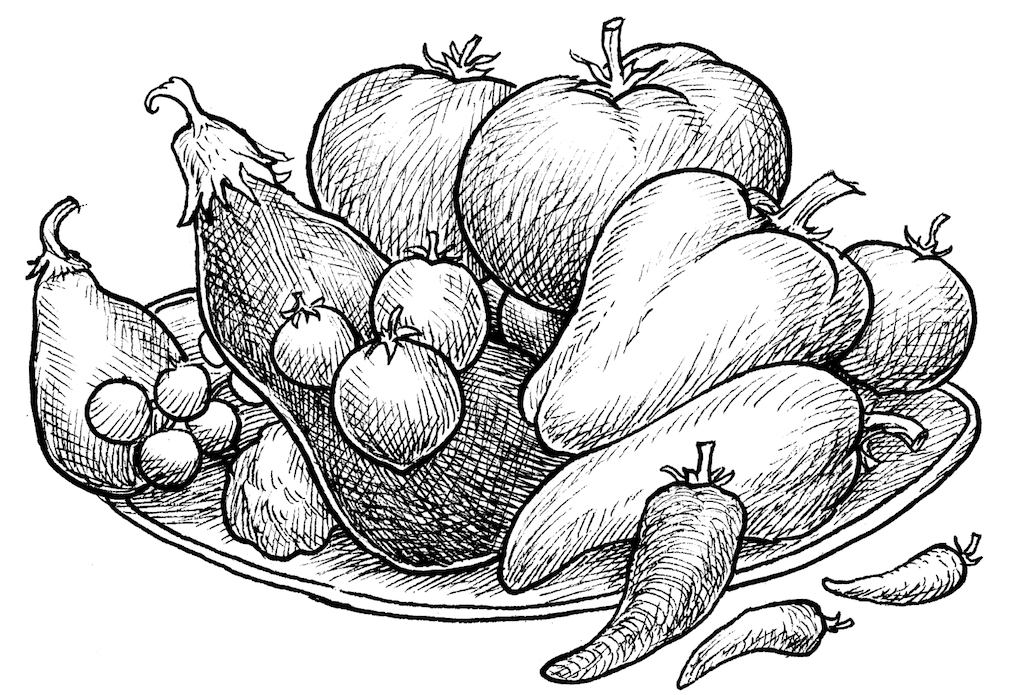By Teresa Gale
In this final stretch of the growing season, your plants will put one last push into fruiting. For crops that are still maturing, like peppers, eggplants, melons, winter squash, and indeterminate tomatoes, pinch off any new blossoms that you see to direct the plant’s energy toward ripening existing fruit, rather than producing new fruit. There isn’t enough time left in the season for new fruit to fully ripen.
Observing the life cycle of winter squash can be a good test of your patience. Don’t be tempted to pick them early. They’re worth the wait! When the vine starts to die, they’ll be ready to harvest. This usually happens in late October or near the first frost.
Potatoes should be fully mature this month once their foliage dies off. To harvest them, dig carefully in the soil around the plants, either by hand or with a garden spade or fork. Start from the outside to avoid cutting or bruising the tubers. You can also gently pull up the entire plant, and most of the potatoes will remain attached. Make sure to dig around in the soil one more time to find any stragglers.
It’s okay if you end up with some bruised or cut spuds. Just make sure to eat them right away, since they won’t keep for very long. Otherwise you can store potatoes that are in good condition. First let them sit or “cure” for a week or two at room temperature. Then place them in a burlap or brown paper bag with holes to protect them from light, which can cause them to turn green and taste bitter. Green potatoes also contain a toxic chemical that can cause indigestion, so it’s best to avoid eating them. Transfer your tubers to a cool, humid location (40-45˚F is ideal), and they’ll keep for up to two months.
Other root vegetables such as carrots, beets, turnips, and onions can be harvested as needed. Or you can leave them in the ground for a few more weeks, since they can tolerate cooler temperatures. Like potatoes, if you plan to store onions, make sure to cure them first. Exposure to warm temperatures for 1-2 weeks will thicken their skins and heal surface wounds. Don’t wash root vegetables (potatoes included) until you’re ready to use them, since the added moisture can encourage mold growth. Also, avoid storing potatoes and onions together, as each one emits a gas that causes the other to spoil faster than normal.
You’re probably still getting some beans at this point. As an alternative to picking them fresh, you can wait until the beans bulge and mature inside the pods. The pods will be green and inedible, but you can still shell the beans and cook them (they’re actually called “shelly” beans at this stage). Or you can let the pods stay on the vine until they turn brown and dry out completely, and either harvest and prepare them as you would other dry beans, or save them for next year’s sowing.
If you have plants that are no longer bearing fruit, you can go ahead and remove them. Even if their foliage looks green and healthy, it’s too late in the season for these plants to produce fruit of edible size. Avoid pulling up plants by hand unless they’re root vegetables or have small root systems. Uprooting a plant in this way—especially a large, heavily rooted one—can disrupt your soil balance, and make a big mess in the process. It’s best to remove plants by cutting their stems at the soil level with pruning shears (for stems that are tough, use loppers or a hand saw). The remaining roots should break down into the soil by the time you’re ready to plant again in the spring.
Excerpt and illustrations from Fearless Food Gardening in Chicagoland reprinted with permission from the Peterson Garden Project. The book is available for purchase at petersongarden.org.

























No Responses to “Fearless Food Gardening in Chicagoland: Harvest and Maintenance”